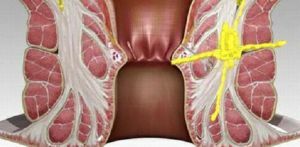 According to the definition, a fistula is a channel between hollow organs or a hollow organ and the surface of the body.
According to the definition, a fistula is a channel between hollow organs or a hollow organ and the surface of the body.
A fistula( or fistula) of the rectum is formed between the intestine and the surface of the skin around the anus.
Contents
- How is the fistula formed?
- Fistula classification
- What does the violation indicate?
- Diagnostic methods
- RAP fistula therapy
- Possible complications
- Warning and armed with
How is the fistula formed?
Usually, fistula is a consequence of the paraproctitis, which is not cured until the end, which is the inflammation of fatty tissue that surrounds the rectum.
When the disease is in acute form, the abscess, located deep in the fiber, is opened, and the inside of the pus comes out.
The patient's condition thus becomes easier and often people take it for recovery. However, a channel remains in the wall of the intestine, the space around which remains inflamed. Because of this, the tissues gradually begin to break down, leaving the surface of the body.
The development of fistula is facilitated by the factor that the channel left after the breakthrough of the contents of the ulcer is constantly infected with
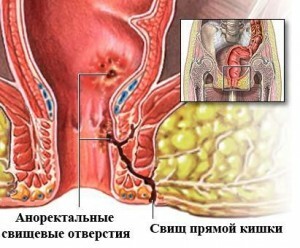
. The photo shows where the fistula of the rectum of the
is most often localized with calves and gases, which contributes to the development of inflammation.
Occasionally fistula may form as one of the complications after surgical treatment of hemorrhoids.
This occurs if the surgeon incorrectly made suturing the edges of the mucosa.
Since the anus is constantly infected, inflammation begins in the walls of the intestine. Then the process develops in the same way as in the case of paraproctitis.
Sometimes fistulas result from various injuries of the rectal mucosa: if the affected area is inflamed, the likelihood of fistula development is high.
Fistula classification
Three types of fistula of the rectum are distinguished:
- Complete fistulas have two openings. One of them opens into the lumen of the rectum, and the second is located near the anus.
- The incomplete fistula has only one hole. There is an opinion that an incomplete fistula is just one of the stages of the formation of a complete fistula, and it should not be singled out as a separate category. Indeed, if the development of the fistula is not diagnosed in time, sooner or later the surrounding tissues will collapse due to the inflammatory process and the fistula will open outward.
- The feature of the internal fistula is that they have two openings that open into the rectal wall.
There is another classification of fistulas, based on the location of the outlet, according to this parameter fistulas are divided into intrasfinctory, pre-infunctured and per-inflexional.
Features of each form of fistulae:
- Intra-sphincter has an outlet that is located near the anus. Such fistulas are also called marginal, or subcutaneous-submucosal.
- The channel of the fistula can pass at different depths. The main feature of such fistulas is that they can branch out as you move away from the anus, while new inflammatory foci are formed in adipose tissue. Around the hyperspecific fistulas, a scar tissue forms, which often seizes the anus, which leads to a disruption in its function and deformation.
- Vnesfinkternye fistulas have a long enough stroke, they often have a sinuous structure, around them are formed purulent fouling and new foci of inflammation. In this case, inflammation often goes to fatty tissue located on the opposite side of the rectum, which causes the development of a fistula that has a horseshoe shape.
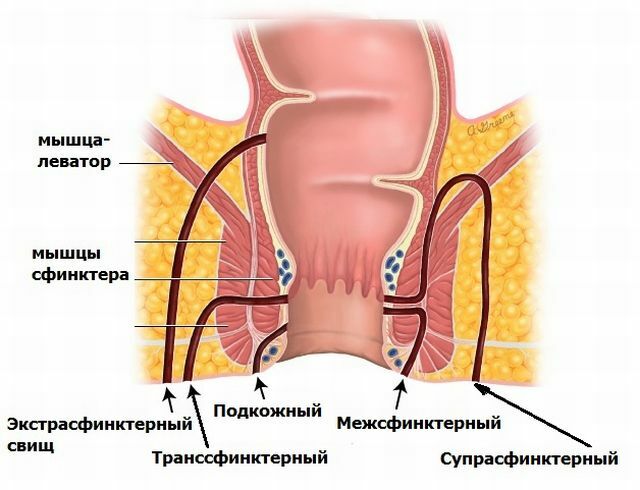
What does the violation indicate?
The following symptoms indicate the development of the fistula of the rectum:
- nasty itching around the anus;
- patients notice bloody or purulent discharge from the anus, often the allocation is so intense that the patient has to use daily hygiene pads;
- sensation of pain in the rectum, which increases during defecation, after a long stay in one position, as well as with coughing and laughing;
- from time to time there is a slight increase in body temperature.
These symptoms are of a periodic nature, either appearing or disappearing.
As fistula develops and new inflammatory foci develop, fatigue and drowsiness can occur, and often patients complain of severe headaches. In men, these symptoms are accompanied by sexual dysfunction.
Diagnostic methods
At the moment when the fistula breaks out, the diagnosis of the disease is not particularly difficult.
However, in any case, the doctor will not diagnose, based only on general examination.
Diagnosis of fistulas is performed using the following methods:
- introduction to the intestines of the colorant, followed by monitoring where it emerges from;
- endoscopic examination;
- X-ray examination using a contrast medium;
- ultrasound;
- microbiological examination of excreta.
As an additional study, a cytological analysis of the discharge can be assigned. This is necessary in order to find out whether the symptoms are a sign of the development of cancer.
Therapy of rectal fistula
Fistula is maintained until the inflammation in the tissues of the subcutaneous fat is eliminated. Therefore, all patients who are diagnosed with this disease are advised to surgically remove both the fistula and inflamed tissues.
The choice of technique of operation depends on a number of factors:
- on the type of fistula and its location relative to the anus;
- from the presence of scar tissue around the fistula;
- on the degree of defeat of the inflammatory process of subcutaneous fat.
At the heart of all surgical techniques for treating the disease is the removal of fistula and inflamed fat. Usually the operation 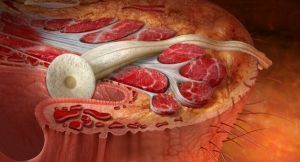 is combined with medical therapy: patients are prescribed antibiotics, which allow getting rid of the inflammatory process.
is combined with medical therapy: patients are prescribed antibiotics, which allow getting rid of the inflammatory process.
If the rectal fistula is diagnosed at an early stage, conservative treatment without surgery, which consists in taking antibiotics and pain medications, can be used.
However, often conservative treatment does not lead to the desired result and one has to resort to surgery.
Many patients, after learning about the diagnosis, try to get rid of fistula using folk methods.
However, some folk methods can be used to ease your condition, of course, after consulting with your doctor.
If the fistula is not deep, the use of a mixture of vodka and olive oil helps: both these components are mixed in equal proportions, after which the mixture should be rubbed into the affected area.
Also helps the use of an aqueous mummy solution with the addition of a small amount of aloe juice. A bandage soaked in a mixture must be applied to the fistula for 15 minutes twice a day.
The rectum in which the fistula is located and its excision is surgically:
Possible complications of
If the patient does not consult a doctor on time, after experiencing unpleasant symptoms, complications can develop that include:
- anus deformation;
- the appearance of scar tissue in the walls of the anal canal, which leads to difficulty in defecation;
- scar changes in muscle tissue;
- development of cancer.
Warned and equipped with
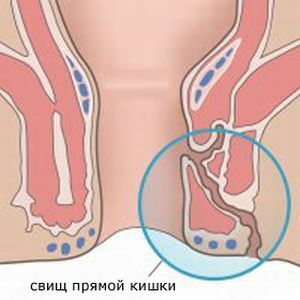 To avoid the development of the fistula of the rectum, first of all, you should seek medical help in case of paraproctitis symptoms.
To avoid the development of the fistula of the rectum, first of all, you should seek medical help in case of paraproctitis symptoms.
It is worth remembering that patients who require surgical operations, for example, with hemorrhoids, anal canal polyps or cancer, it is necessary to resort to surgery in time.
This will avoid the development of complications, including paro-proctitis, which is the main factor leading to the development of the fistula of the rectum.
Fistula of the rectum is a rather unpleasant disease, fraught with the development of various complications. Therefore, you should not postpone an appeal to a doctor-proctologist with the appearance of unpleasant symptoms.
The earlier treatment is started, the easier it will be and the less time will be required for post-operative rehabilitation.
